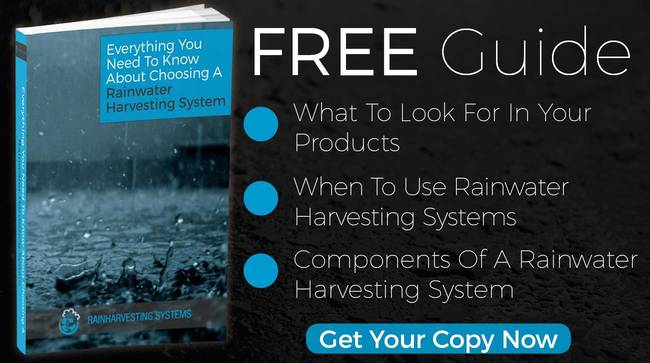How To Filter Rainwater For Drinking
When rainwater first begins its life having just been evaporated from the surface of the planet, information technology is indeed pure H2O. Just as it rises into the heaven and forms clouds, information technology mixes with other substances present in the temper, such as dust, pollen, spores and and then on. Then it falls on your roof and mixes with even more than material, including bird droppings, before being washed downward a pipe to your rainwater harvesting system. That might exist just a simple h2o butt at the bottom of a drainpipe that you use to water the roses, or it could be a more than sophisticated organization that provides water for WCs, laundry use, industrial processes etc.
Beverage Vs Non-Potable Water
At that place is a meaning divergence betwixt the standards required for garden irrigation compared with drinking water. Potable h2o must exclude such material and also pathogens and microbial pollutants earlier it is considered suitable for bathing, washing dishes and drinking. Usually, all the water we use goes through the necessary treatment steps to produce potable water. With a rainwater harvesting system, merely basic filtration of particles is generally required to requite h2o that is sufficiently clean enough for flushing toilets, washing clothes and watering the garden.
Rainwater Vs Groundwater
Rainwater is usually considerably cleaner than groundwater in near parts of the Uk. The reason being that groundwater can incorporate run-off from roads, industrial and commercial bounds, besides as from agricultural activity and fertilisers. It will besides often be discoloured from the soil which it passes through. By contrast, water obtained through boreholes from aquifers deep surreptitious may exist equally pure every bit, if not purer, than rainwater if it has filtered down through many layers of stone and rock. Of course, in limestone areas of the land this water may also be very 'hard' due to its high lime content. However, rainwater will ever be soft with a typical pH value of v.6.
1. Preventing Algae & Bacterial Growth
Warmth and light promote the growth of algae and other organisms. Therefore information technology is important for higher up ground storage tanks to be constructed from an opaque material and if possible shielded from direct sunlight. Good insulation which provides frost protection for the winter months as well acts to keep things cool during summer.

2. Master Filtration
Fifty-fifty if all y'all use is a water butt, a simple get-go stride that keeps larger fabric out of your rainwater storage arrangement will ensure your water stays fresher for longer. Filtration can be every bit uncomplicated as some course of mesh or strainer fixed across the inlet to your storage system and cleaned regularly. Better still is to utilize a proprietary filter, preferably a stainless steel i for performance and durability.
 3. Sedimentation
3. Sedimentation
A certain amount of sediment is unavoidable in whatever harvesting organisation, as the technique relies upon water passing through a mesh or grill under gravity. There will e'er be some fine particles that get through, depending on the course of the filter. Obviously the effectively the filter, the less material will get through to the tank, so ideally the filter should remove annihilation larger than 1mm, and smaller if possible. Good quality filters will filter down to less than 0.5mm, so the collected water appears as clean as tap h2o. The best filters such as the Vortex filter are nigh cocky-cleaning, requiring attention just a few times each year, and have the added benefit of introducing oxygen into the h2o. A simple calming arrangement that ensures the water is taken to the bottom of the tank will minimise the disturbance to any sediments that exercise accrue. An outlet pipe that takes water non from the bottom of the storage tank but from some point further upwards will avert any sediment getting through. Even though fine sediment will build up in the tank over the years, this will not cause a problem if these simply steps are taken.
 4. Avant-garde Purification For Beverage Water
4. Avant-garde Purification For Beverage Water
An ultra violet light source in the form of a UV Filter is a very effective method of removing the threat from pathogens and microbial organisms. It works by destroying the Deoxyribonucleic acid of the organisms, thus rendering them harmless. For a UV filter to work effectively, minute particles must first exist filtered out past a particulate filter to prevent organisms being 'shaded', which would not and so be exposed to the UV light.
Carbon filtration is sometimes added to amend the taste of the water, depending on the vessel the water has been stored in, merely this is optional and a matter of personal preference.
Adjacent Steps
Rainwater harvesting systems are growing in popularity for new builds of all types and sizes because eco-friendly buildings and homes have added marketing attraction in the eyes of potential purchasers. Call us today for more data and to observe out how nosotros tin work with yous on your next build to deliver a functional and environmentally friendly rainwater harvesting feature. Call 01452 772000 or email sales@rhsl.co.uk.

How To Filter Rainwater For Drinking,
Source: https://rainharvesting.co.uk/4-tips-on-how-to-purify-rainwater-where-you-need-to-start/
Posted by: reeseacceent.blogspot.com

 4. Avant-garde Purification For Beverage Water
4. Avant-garde Purification For Beverage Water
0 Response to "How To Filter Rainwater For Drinking"
Post a Comment